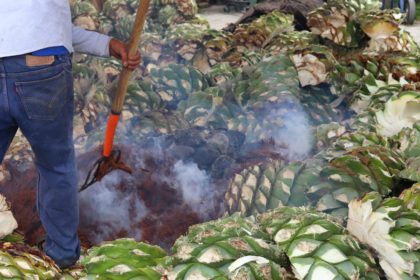
A research team has made the first comprehensive analysis of Mexico’s traditional ferments. Utilizing the country’s native cacti, agaves and maize, these diverse beverages are unique to their region. But they are poorly studied, and some are endangered as they fall out of style with younger generations.
“Many of Mexico’s finest microbiologists and ethnobotanists are giving ever-greater attention to this fascinating but once-forgotten foodscape, but even they are willing to admit that we’re just beginning to scratch below the surface of understanding all the biodiversity in these bottles of blessed ferment,” says Gary Paul Nabhan, research scientist at the Southwest Center of the University of Arizona (U of A).
Researchers in various disciplines (microbiology, ethnoecology and genetics) from five different schools (U of A and four universities in Mexico) took part in the study. The results, Traditional Fermented Beverages of Mexico: A Biocultural Unseen Foodscape, are published in the international journal Foods.
Sixteen traditional Mexican fermented beverages were identified: tepache, pulque, hobo, Mexican wines, colonche, nawait, pozol, sidra, tejuino, tesgüino, taberna, cocoyol, tuba, Mexican palm wine, balché and xtabentún. Those 16 drinks were made from 143 plant species and include 102 genre of microorganisms.
In each region, “a distinctive set of plant roots, leaves, fruits and stems were added as fermentation catalysts, flavorants, colorants and stabilizers,” reads the U of A press release. “A large number of bacterial strains and yeasts — in addition to common brewer’s yeasts and water kefir grains — enabled the nutritional transformation of these raw materials into a wide array of unique nutritionally rich, probiotic beverages.” The team mapped the regional variations and ecological niches of the fermented drinks.
Sustainable Future
The study notes this level of analysis is “indispensable” to promote fair trade and sustainable food production. Industrial mezcal, for example, has created a monoculture of blue agave, and farm labor often works in exploitative conditions.
“These products have been embedded as part of the daily lives of many people, including those currently marginalized rural or Indigenous groups,” the study reads. “The diversity of fermented products is an outstanding reservoir of genetic resources that has high potential to obtain secondary products such as extracts, enzymes, dyes, and others compound that can be involved in global markets and could help to solve problems such as hunger and poverty and may play a key role to reinforce cultural identity..”
Traditional Mexican fermented beverages also provide important nutrients for consumers as the globe battles a changing climate.“The naturally-occurring yeasts and kefir-like tibico grains found in association with prickly pear cacti, saguaro fruit, century plants and desert spoons (sotols) likely tolerate much higher ambient temperatures than those from the semi-arid highlands and wet tropical forests,” Nabhan explains.
Extinct Drinks
Some healthier artisanal drinks “have fallen out of fashion and face local or broad extinction,” the press release notes. In some areas of the country, these “forgotten ferments” are still used in the home, but not commercialized.
“Now that the days of Prohibition are over and there is a great need for arid-adapted crops with highly-efficient water use, some of these traditional agave and cactus varieties should be revived for the local production of healthful beverages,” Nabhan suggests. “In fact, traditional beverages such as tepache, tesguino and colonche have made a comeback in the Tucson, Arizona, region since it received recognition as a UNESCO City of Gastronomy. These traditional beverages are also being employed by mixologists in novel cocktails now being featured in nearly every state of Mexico.
